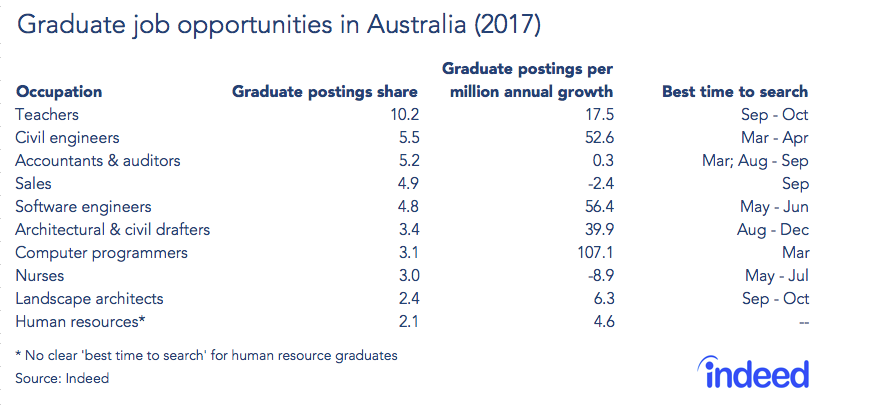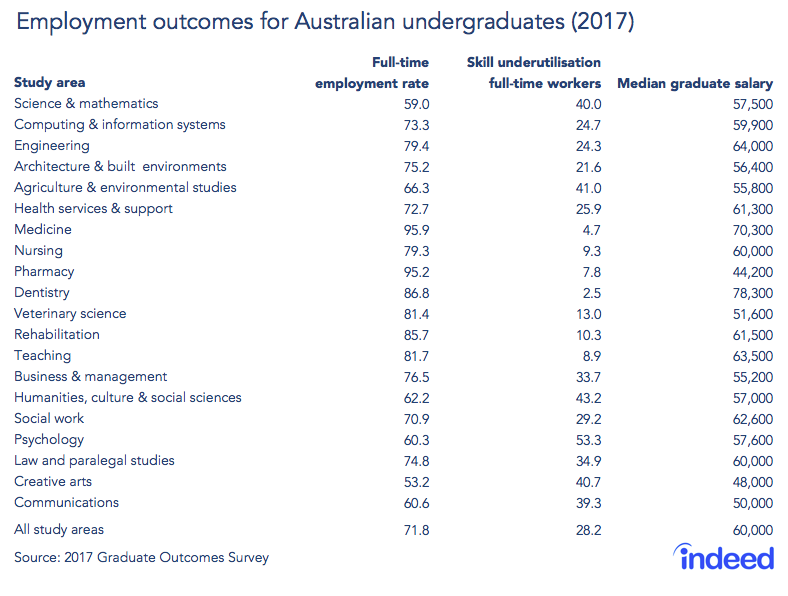Key points:
- Only 72% of students who complete an undergraduate degree find full-time employment within four months of graduation–well below what was normal before the global financial crisis.
- Graduate job postings increased 23% and 19% in 2017 and 2016 respectively.
- Indeed data on graduate job postings point toward further improvement in full-time employment among recent graduates.
The final year of university is, for many students, a difficult balancing act between studying and applying for work after graduation. Jobs for graduates begin to appear online early in the year, but competition can be fierce and close to 30% of graduating students fail to find full-time positions within four months of earning their degree.
The good news is that full-time employment opportunities for students with an undergraduate degree are on the rise. It is still more difficult for graduates to find work than it was before the global financial crisis, but Australian companies are now hiring at a record pace. Indeed data on graduate job postings suggest this improvement continued throughout 2017.
Using Indeed job posting data and research from the 2017 Graduate Outcomes Survey, we find:
- The best undergraduate degrees for finding full-time work are medicine, pharmacy and dentistry. The worst: creative arts, science and mathematics.
- Around 28% of recent graduates in full-time work report their skills are underutilised in their current roles. This jumps to 41% if we include graduates in part-time positions.
- The highest-earning degrees are dentistry at $78,300 and medicine at $70,300, followed by engineering at $64,000.
- Graduate job postings increased 23% in 2017 following a 19% jump in 2016.
- Around 10% of graduate job postings are for teachers, with 5.5% for civil engineers, and 5.2% for accountants and auditors.
- Postings for graduate jobs top out in March, although for some professions the peak occurs later.
Recent trends in undergraduate employment
Using Indeed job posting data, we can assess the demand for recent graduates. Graduate job postings are increasing strongly, a sign that more Australian businesses are looking to hire newly graduated talent.
The number of graduate job postings per million job postings rose 23% in 2017. This is particularly impressive given the improvement in the Australian labour market in 2017, with employment rising 3.3% and the unemployment rate tumbling to a five-year low. It followed a 19% increase in graduate job postings in 2016.
Around 10% of graduate job postings are for teachers, with postings for teaching jobs rising 17.5% in 2017. The best time to apply for these jobs is in September and October, a little later than for most graduate roles.
For other occupations, such as engineering and computer programming, jobs tend to appear online in March and April, with graduate intakes confirmed by mid-year. By comparison, accounting appears to have two hiring seasons: one in March and a second beginning in August.
Demand for tech graduates is soaring, with job postings for software engineers and computer programmers posting strong gains in 2017. No surprise there, given the increasing importance of technology to Australian business operations. By contrast, the softer market for nursing graduates is puzzling in light of the robust demand for healthcare professionals.

Employment outcomes for graduates
According to the 2017 Graduate Outcomes Survey, almost 72% of students who recently completed an undergraduate degree were in full-time employment within four months of graduation. But this must be seen in perspective. Since the global financial crisis, it has been more difficult for graduates to gain a foothold in the labour market. The full-time employment rate among recent graduates was around 85% in 2008 and plummeted to a low of 68% in 2014.
Younger workers were disproportionately harmed by the global financial crisis. Youth unemployment and underemployment shot up as Australian businesses reduced their annual graduate intake. Although progress has been made, the employment numbers among younger workers continue to lag those of the rest of the Australian labour force.
Around one in five recent graduates are underemployed, up from one in ten in 2008, over double the underemployment rate across the entire labour force. Many undergraduates struggle to find the right job, with 28% of full-time workers reporting they were in positions that did not fully utilise their skills or education.
The employment prospects for undergraduates depend to a large degree on their study area. Some degrees provide greater opportunity than others both in terms of the number of jobs available and potential salary.
Undergraduates from vocational study areas with clear career paths tend to have greater success in finding work on graduation. Almost 96% of undergraduates with medical degrees and 95% of pharmacy graduates find full-time employment within four months of graduating.
By comparison, just 59% of undergraduates in science and mathematics are employed full-time within four months of graduating. This may appear odd, but many jobs in this area require postgraduate training. Postgraduate studies provide science and mathematics majors greater specialisation and skill development, and create a clearer career path after university. Consequently, 44% of science and mathematics graduates go on to postgraduate studies–over twice the rate in other study areas.
This is also true of psychology, where postgraduate qualifications are a prerequisite to work as a practicing psychologist. Almost 37% of psychology undergraduates pursue postgraduate studies, second only to science and mathematics.
For those motivated by money, the best option might be dentistry. Dental graduates took in a hefty median salary of $78,300 in 2017. Teaching might be a fallback position for many students, but the $63,500 median salary it commands is nothing to sneeze at. By comparison, pharmacy undergraduates excel by one standard but do not impress by the other: They have great job prospects, but can expect a salary of only around $44,200, at the bottom of the list.
The table below shows full-time employment, skill underutilisation and median salaries for 20 study areas in 2017. The figures are for the 2016 graduating class, most of whom began employment in early 2017.

Combining data from Indeed with the 2017 Graduate Outcomes Survey indicates full-time opportunities picked up still further for the class of 2017. A strong rise in job postings combined with record employment growth across Australia should lead to a larger share of graduates finding full-time work within four months of graduation. Although job-finding success for younger Australians continues to track well below pre-crisis levels, the news for graduates is the best it has been in years.
Methodology:
To analyse the employment outcomes of recent graduates, we used job posting data for Australia that filtered for job titles including the word ‘graduate’. This identifies graduate programmes and opportunities by Australian employers that mainly go to students completing the final year of their undergraduate degree.
Job postings have limitations as a measure of graduate job opportunities. First, the number of postings is not the same as the number of jobs available. Some postings refer to ‘graduate programme’, which means that a single job posting could refer to multiple positions. Second, not every graduate opportunity is posted online. In some occupations–for example medicine–graduates find employment through placements rather than online job postings.
